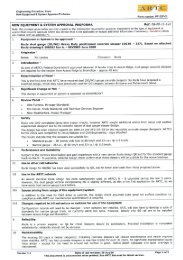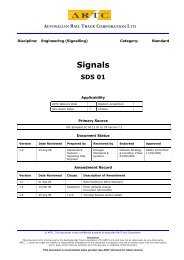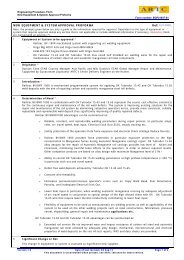Headway SDS 02 –(RIC Standard: SC 00 13 01 02 SP)
Headway SDS 02 –(RIC Standard: SC 00 13 01 02 SP)
Headway SDS 02 –(RIC Standard: SC 00 13 01 02 SP)
You also want an ePaper? Increase the reach of your titles
YUMPU automatically turns print PDFs into web optimized ePapers that Google loves.
Discipline<br />
Engineering <strong>Standard</strong> <strong>–</strong>NSW<br />
Category<br />
Signalling<br />
Title<br />
<strong>Headway</strong><br />
Reference Number<br />
<strong>SDS</strong> <strong>02</strong> <strong>–</strong>(<strong>RIC</strong> <strong>Standard</strong>: <strong>SC</strong> <strong>00</strong> <strong>13</strong> <strong>01</strong> <strong>02</strong> <strong>SP</strong>)<br />
Document Control<br />
Superseded<br />
Status Date Prepared Reviewed Endorsed Approved<br />
Issue 1<br />
Revision 2<br />
Mar 05<br />
<strong>Standard</strong>s and<br />
Systems<br />
Refer to<br />
Reference<br />
Number<br />
<strong>Standard</strong>s<br />
Engineer<br />
GM<br />
Infrastructure<br />
Strategy &<br />
Performance<br />
H Olsen M Owens<br />
Safety<br />
Committee<br />
Refer to minutes<br />
of meeting<br />
12/08/04
Engineering <strong>Standard</strong> <strong>–</strong>NSW<br />
Signalling <strong>SDS</strong> <strong>02</strong><br />
<strong>Headway</strong><br />
DI<strong>SC</strong>LAIMER<br />
Australian Rail Track Corporation has used its best endeavors to ensure that the<br />
content, layout and text of this document is accurate, complete and suitable for its<br />
stated purpose. It makes no warranties, express or implied, that compliance with<br />
the contents of this document shall be sufficient to ensure safe systems of work or<br />
operation. Australian Rail Track Corporation will not be liable to pay compensation<br />
in respect of the content or subsequent use of this document for any other purpose<br />
than its stated purpose or for any purpose other than that for which it was<br />
prepared except where it can be shown to have acted in bad faith or there has<br />
been willful default.<br />
DOCUMENT APPROVAL<br />
The technical content of this document has been approved by the relevant ARTC<br />
engineering authority and has also been endorsed by the ARTC Safety<br />
Committee.<br />
DOCUMENT SUPPLY and CONTROL<br />
The Primary Version of this document is the electronic version that is available<br />
and accessible on the Australian Rail Track Corporation Internet and Intranet<br />
website.<br />
It is the document user’s sole responsibility to ensure that copies are<br />
checked for currency against the Primary Version prior to its use.<br />
COPYRIGHT<br />
The information in this document is Copyright protected. Apart from the<br />
reproduction without alteration of this document for personal use, non-profit<br />
purposes or for any fair dealing as permitted under the Copyright Act 1968, no part<br />
of this document may be reproduced, altered, stored or transmitted by any person<br />
without the prior written consent of ARTC.<br />
Superseded<br />
Issue 1 © Australian Rail Track Corporation<br />
Revision 2 This document is uncontrolled when printed<br />
March 2<strong>00</strong>5 Page 2 of 8
Engineering <strong>Standard</strong> <strong>–</strong>NSW<br />
Signalling <strong>SDS</strong> <strong>02</strong><br />
<strong>Headway</strong><br />
About This <strong>Standard</strong><br />
This Principle addresses the requirements for determining the distance<br />
between running signals. It also addresses the spacing between a series of<br />
signals.<br />
Superseded<br />
Issue 1 © Australian Rail Track Corporation<br />
Revision 2 This document is uncontrolled when printed<br />
March 2<strong>00</strong>5 Page 3 of 8
Engineering <strong>Standard</strong> <strong>–</strong>NSW<br />
Signalling <strong>SDS</strong> <strong>02</strong><br />
<strong>Headway</strong><br />
Document History<br />
Primary Source <strong>–</strong><strong>RIC</strong> <strong>Standard</strong> <strong>SC</strong> <strong>00</strong> <strong>13</strong> <strong>01</strong> <strong>02</strong> <strong>SP</strong> Version 3.0<br />
List of Amendments <strong>–</strong><br />
ISSUE DATE CLAUSE DE<strong>SC</strong>RIPTION<br />
1.1 <strong>01</strong>/09/2<strong>00</strong>4 Reformatting to ARTC <strong>Standard</strong><br />
1.2 14/03/2<strong>00</strong>5 Disclaimer Minor editorial change<br />
Footer reformatted<br />
Superseded<br />
Issue 1 © Australian Rail Track Corporation<br />
Revision 2 This document is uncontrolled when printed<br />
March 2<strong>00</strong>5 Page 4 of 8
Engineering <strong>Standard</strong> <strong>–</strong>NSW<br />
Signalling <strong>SDS</strong> <strong>02</strong><br />
<strong>Headway</strong><br />
Contents<br />
1 <strong>Headway</strong> ............................................................................................................................ 6<br />
1.1 Principle No. 2.1 - <strong>Headway</strong> Concepts And Definitions ........................................................6<br />
1.1.1 Introduction ..............................................................................................................................6<br />
1.1.2 <strong>Headway</strong> - Concept .....................................................................................................................6<br />
1.1.2.1<strong>Headway</strong> - Definition ...................................................................................................................6<br />
1.1.3 Signal Spacing - Concept ............................................................................................................6<br />
1.1.3.1Signal Spacing - Definition ..........................................................................................................6<br />
1.1.4 Sighting Point - Concept ..............................................................................................................6<br />
1.1.4.1Sighting Point - Definition ...........................................................................................................6<br />
1.1.5 Sighting Distance - Concept ........................................................................................................7<br />
1.1.5.1Sighting Distance - Definition .....................................................................................................7<br />
1.2 Principle No. 2.2 - Section Intentionally Left Blank ................................................................8<br />
1.3 Principle No. 2.3 - Distance Between Running Signals .........................................................8<br />
1.3.1 Introduction ..............................................................................................................................8<br />
1.3.2 Minimum Distance Between Running Signal Aspects .................................................................8<br />
1.3.3 Maximum Distance Between 3 Aspect Running Signals .............................................................8<br />
Superseded<br />
Issue 1 © Australian Rail Track Corporation<br />
Revision 2 This document is uncontrolled when printed<br />
March 2<strong>00</strong>5 Page 5 of 8
Engineering <strong>Standard</strong> <strong>–</strong>NSW<br />
Signalling <strong>SDS</strong> <strong>02</strong><br />
<strong>Headway</strong><br />
2 <strong>Headway</strong><br />
2.1 Principle No. 2.1 - <strong>Headway</strong> Concepts And Definitions<br />
2.1.1 Introduction<br />
This Principle addresses the concept of headway and provides further definitions<br />
and concepts for the various factors affecting headway.<br />
2.1.2 <strong>Headway</strong> - Concept<br />
The headway on any section of railway line is a measure of the capacity to pass<br />
trains through the section.<br />
If a complete line is to have uniform headway throughout, then all sections of the<br />
line must be considered and the factors affecting headway adjusted to ensure<br />
that uniform headway can be achieved.<br />
<strong>Headway</strong> is often expressed as a time increment in minutes and perhaps seconds<br />
rather than the number of trains passing over a line during each hourly interval.<br />
<strong>Headway</strong> may be stated for trains of a specific type or performance.<br />
2.1.2.1 <strong>Headway</strong> - Definition<br />
The headway is the time interval between successive trains running at the line<br />
speed on clear signal aspects.<br />
2.1.3 Signal Spacing - Concept<br />
As headway considerations become critical to the performance of train services<br />
then it is necessary to provide a system of evenly time-spaced signals having<br />
regard to the effect of line speed, braking and gradient.<br />
Superseded<br />
2.1.3.1 Signal Spacing - Definition<br />
The distance between a series of successive signals provided to achieve a<br />
particular headway for a line.<br />
2.1.4 Sighting Point - Concept<br />
Adequate signal sighting point is essential if the drivers of trains are to be<br />
allowed to take the maximum advantage of the signal aspects ahead of them.<br />
Poor sighting can have a detrimental effect on headways in practice.<br />
2.1.4.1 Sighting Point - Definition<br />
The sighting point is the point in rear of a signal at which the driver of a train is<br />
first able to view the signal.<br />
Issue 1 © Australian Rail Track Corporation<br />
Revision 2 This document is uncontrolled when printed<br />
March 2<strong>00</strong>5 Page 6 of 8
Engineering <strong>Standard</strong> <strong>–</strong>NSW<br />
Signalling <strong>SDS</strong> <strong>02</strong><br />
<strong>Headway</strong><br />
2.1.5 Sighting Distance - Concept<br />
This is directly related to signal sighting and provides for a predetermined<br />
minimum distance at which a driver can always observe a signal before reaching<br />
it.<br />
2.1.5.1 Sighting Distance - Definition<br />
The sighting distance is the distance between the sighting point and the<br />
signal to which it applies.<br />
Superseded<br />
Issue 1 © Australian Rail Track Corporation<br />
Revision 2 This document is uncontrolled when printed<br />
March 2<strong>00</strong>5 Page 7 of 8
Engineering <strong>Standard</strong> <strong>–</strong>NSW<br />
Signalling <strong>SDS</strong> <strong>02</strong><br />
<strong>Headway</strong><br />
2.2 Principle No. 2.2 - Section Intentionally Left Blank<br />
2.3 Principle No. 2.3 - Distance Between Running Signals<br />
2.3.1 Introduction<br />
This Principle addresses the requirements for determining the distance<br />
between running signals. It also addresses the spacing between a series of<br />
signals.<br />
2.3.2 Minimum Distance Between Running Signal Aspects<br />
The minimum distance between a signal showing a first warning aspect and the<br />
stop signal to which it applies shall not be less than the “longest braking<br />
distance”.<br />
This distance shall be determined in accordance with Principle 3.2.<br />
The minimum distance between a signal showing the first warning aspect and a<br />
points turnout to which it applies shal not be less than the “longest braking<br />
distance” to reduce to the restricted speed required for the points turnout.<br />
The minimum distance between a signal showing the first warning aspect and a<br />
subsidiary signal showing a proceed aspect shal be the “longest braking<br />
distance” to reduce to the restricted speed required by the subsidiary signal<br />
proceed aspect where such restricted speed is applicable.<br />
2.3.3 Maximum Distance Between 3 Aspect Running Signals<br />
Superseded<br />
The distance between 3 aspect running signals shall generally be limited to<br />
4,<strong>00</strong>0m and exceptionally to an absolute limit of 4,5<strong>00</strong>m.<br />
If the distance between two successive running signals is greater than 1.5 Km<br />
and more than 1.5 times the service braking distance then the sighting distance<br />
of the second signal shall be greater than the minimum sighting distance<br />
specified in Principle 1.12, and the overlap distance for the first signal beyond<br />
the second signal should be greater than the normal minimum overlap distance<br />
specified in Principle 4.2, such that the sighting distance and the overlap<br />
distance together are greater than their combined minimum distances to an<br />
extent commensurate with the greater distance between the signals.<br />
Issue 1 © Australian Rail Track Corporation<br />
Revision 2 This document is uncontrolled when printed<br />
March 2<strong>00</strong>5 Page 8 of 8















